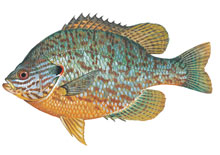Freshwater Fish - Species
Species Specific Regulations
Pumpkinseed
Freshwater Fishing License required.
Pumpkinseed (Lepomus gibbosus) - Native
Description: (Anatomy of a Fish)
The pumpkinseed is easily recognized by the wavy and iridescent blue lines that radiate from the mouth along the side of its head. The sides of the body fade from olive, covered with gold and yellow flecks, to blue green covered with orange spots, to a yellow or orange belly. The dorsal, anal and caudal fins are decorated with brown wavy lines or orange spots. The pectoral fin is long and pointy and usually extends far past the eye when bent forward. The gill cover or operculum is stiff, short and mostly black with a light colored edge of bright orange to red-orange. The mouth is small. Pumpkinseeds have pharyngeal teeth, which are molar shaped teeth located in the throat area of the fish.
Range: Statewide
Average Length: 4-6 inches
Average Size: 2-4 ounces
South Carolina State Record: 2 pounds 4 ounces (1997)
Life Expectancy: Approximately 8 years
Preferred Habitat
Pumpkinseeds can survive and reproduce in a variety of habitat types including pools and backwaters or streams, rivers, ponds and reservoirs over a variety of bottoms. They prefer the vegetated areas of these habitat types.
Food Habits
- Aquatic insects, mussels, snails and crayfish.
Spawning
- Pumpkinseed begin to spawn when water temperatures exceed 70 degrees Fahrenheit around late spring to early summer.
- Males construct nests in shallow water either singularly or in loose groups.
- Females can produce up to 14,000 eggs during a laying season. However, they produce 2,000-3,000 sticky eggs at one time in the bottom of their sandy nests.
- The male fertilizes the eggs, guards them throughout incubation and protects them during their early development.
Miscellaneous
Pumpkinseed will often hybridize with other sunfish species, reproducing more than once if conditions are favorable. They rarely reach a size to make them recreationally important to anglers.
Commonly Mistaken Species
One species of fish that is commonly mistaken for this species:
Literature Cited
Rohde, Fred C, Arndt, Rudolf G., Foltz, Jeffery W., Quattro, Joseph M. 2009. Freshwater Fishes of South Carolina. University of South Carolina Press, Columbia, South Carolina.
Wildlife and Freshwater Fisheries Division. 2009. South Carolina Guide to Freshwater Fishes.
Fish Illustration by Duane Raver.


